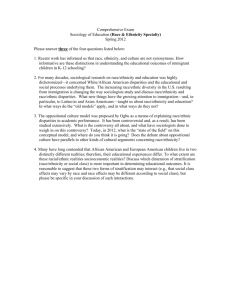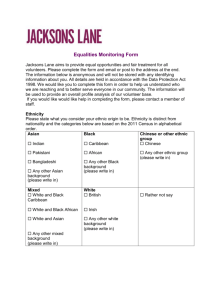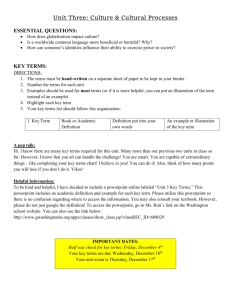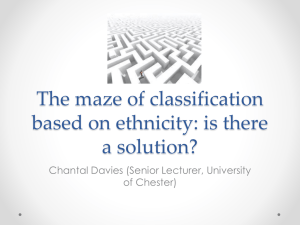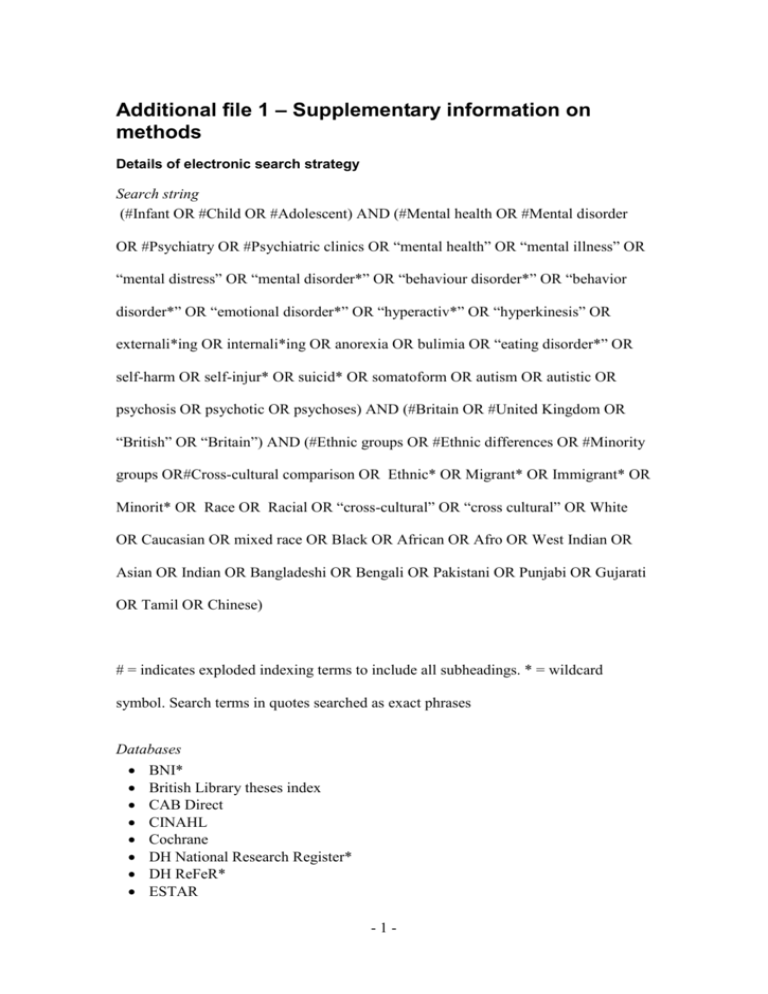
Additional file 1 – Supplementary information on
methods
Details of electronic search strategy
Search string
(#Infant OR #Child OR #Adolescent) AND (#Mental health OR #Mental disorder
OR #Psychiatry OR #Psychiatric clinics OR “mental health” OR “mental illness” OR
“mental distress” OR “mental disorder*” OR “behaviour disorder*” OR “behavior
disorder*” OR “emotional disorder*” OR “hyperactiv*” OR “hyperkinesis” OR
externali*ing OR internali*ing OR anorexia OR bulimia OR “eating disorder*” OR
self-harm OR self-injur* OR suicid* OR somatoform OR autism OR autistic OR
psychosis OR psychotic OR psychoses) AND (#Britain OR #United Kingdom OR
“British” OR “Britain”) AND (#Ethnic groups OR #Ethnic differences OR #Minority
groups OR#Cross-cultural comparison OR Ethnic* OR Migrant* OR Immigrant* OR
Minorit* OR Race OR Racial OR “cross-cultural” OR “cross cultural” OR White
OR Caucasian OR mixed race OR Black OR African OR Afro OR West Indian OR
Asian OR Indian OR Bangladeshi OR Bengali OR Pakistani OR Punjabi OR Gujarati
OR Tamil OR Chinese)
# = indicates exploded indexing terms to include all subheadings. * = wildcard
symbol. Search terms in quotes searched as exact phrases
Databases
BNI*
British Library theses index
CAB Direct
CINAHL
Cochrane
DH National Research Register*
DH ReFeR*
ESTAR
-1-
Embase
HMIC
IBSS
PubMed
PsycINFO
Science and Social Science Citation Index
TRIP
Zetoc
* ‘Britain’-related terms omitted from search strings
Websites
Centre for Evidence in Ethnicity, Health and Diversity
(http://www2.warwick.ac.uk/fac/med/research/csri/ethnicityhealth/)
Centre for Research in Ethnic Relations
(http://www2.warwick.ac.uk/fac/soc/crer)
The NHS Specialist Library for Ethnicity and Health
(www.library.nhs.uk/ethnicity)
Confederation of Indian organisations (http://www.cio.org.uk/)
The Department of Health National electronic library for health
(http://www.kingsfund.org.uk/)
The King’s Fund (http://www.kingsfund.org.uk/)
Mind (National Association for Mental Health)
(http://www.mind.org.uk/Information/Factsheets)
The National Ethnic Minority Data Archive
(http://www.warwick.ac.uk/~errac/nempubs.htm)
Special interest groups and e-mail distribution lists
The Royal College of Psychiatry’s Transcultural Psychiatry special Interest
Group.
The Royal College of Psychiatry’s faculty of Child and Adolescent Psychiatry.
CAMHS@JISCMAIL.AC.UK
YOUNGPERSONS-PSYCHIATRIC-NURSING@WWW.JISCMAIL.AC.UK
MINORITY-ETHNIC-HEALTH@JISCMAIL.AC.UK
-2-
Criteria for the a general populations sample to be considered a comparable
group
Criteria for the general population sample being considered comparable were:
matched for population vs. clinic-based; nationally representative sampling or
representative sampling from the same geographic area (operationalised as a
Government Office Region); same mental health outcome(s) and measures; and
matched for year of data collection to ±10 years.
-3-
Calculation of minimum sample sizes
The minimum size restriction was introduced because null findings involving very
small numbers become ‘uninformative’, being better interpreted as an absence of
evidence rather than evidence of an absence. Moreover, precisely because a null
finding based on so few individuals is so uninformative, such findings are unlikely to
be published and publication bias is likely to become particularly acute. Our
minimum ethnic group sizes are based on power calculations with significance at 5%
and power set at 50% - i.e. the level at which half of genuine differences will be
missed. This, in combination with the assumption of relatively large ethnic
differences, deliberately sets the bar for inclusion quite low. The power calculations
also make allowance for the possibility that a minority group may only make up a
small proportion of the total sample population.
Minimum group size for population-based prevalence or mean score studies
N40 for prevalence for each included ethnic group, corresponding to a
difference of 10 vs. 25% (for questionnaire cut-offs) or 10% vs. 3% (for disorder
prevalences).
N10 for mean scores for each included ethnic group, based on effect size of
0.7.
Minimum group size for clinic-based studies of the relative proportion of referrals/inpatients in clinics from ethnic minority groups
No minimum group size.
-4-
Minimum group size for clinic-based studies of the proportional morbidity of different
disorders
Minimum group size N20 for each included ethnic group, based on moving
from a 50:50 split of e.g. internalising and externalising disorders to a 75:25
split.
-5-
Full details of methodological limitations
Measure of mental health
A: Mental health information only from a questionnaire measure.
B: Reliance on a single, inappropriate informant. Inappropriate informants were
defined as a) self-report by child aged under 11, b) self-report where
oppositionality and hyperactivity are the key outcomes (anti-social behaviour
scales accepted), or c) teacher-report where emotional disorders, eating disorders
or deliberate self-harm are the key outcomes.
C: Non-validated modification of a validated mental health score.
Measurement of ethnicity
D: Method of assigning ethnicity not described.
E: Ethnicity determined by a potentially inferior method. Adequate methods
were child’s self report, parent’s report on child, or according to parent’s
/grandparent’s country of birth/’country of origin.
Other methods were
considered inferior - for example using child’s place of birth, ethnicity as
assigned by name, or ethnicity as ascribed by clinicians. Where case notes were
used to assign ethnicity, but it was not explicitly stated how information on case
notes was completed, this was recorded ?E.
F: Ethnicity analysed using meta-level descriptions only (‘White’ (combining
White British/Irish with White minority), ‘Mixed’, ‘Black’ or ‘Asian’/‘South
Asian’) or by comparing one ethnic group to a potentially mixed-ethnicity
comparison group (e.g. all other children in the sample/the ‘general population’).
Methodological limitations of the study that may cause bias
G: Potential for selection bias - clinic-based sampling.
-6-
H: Potential for selection bias - response rates less than 60% for populationbased surveys or completeness of ethnicity data less than 60% for clinic surveys.
I: Potential for information bias - investigator-based ratings made by the study
authors without being blinded to ethnicity.
Alternative explanations for observed differences
J: Differences could be due to confounding by age and sex (including cases
where no information was given). This was taken to apply unless a) study was
restricted to one sex or age range ≤ 3 years b) similar age (< 1 year difference)
and/or sex profile (<10% difference) was demonstrated in the different ethnic
groups, c) results were stratified by age (age bands ≤ 3 years) and/or sex, or d)
age and/or sex were controlled for in multivariate analyses. This criterion was
NOT applied to clinic based referral rate studies – i.e. it was assumed that the
base population was balanced in its age and sex composition.
K: No data presented on socio-economic position
L: No adjustment made for reported differences in socio-economic position.
-7-



